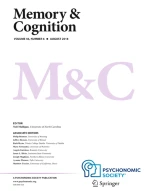Abstract
Studies are reported which show that concrete and abstract words of equal objective frequency (based on available , word counts) are not perceived as being equal. The abstract word has greater perceived frequency than the concrete word. The judged variety of contexts in which a word appears correlates very highly with perceived frequency. The results have relevance to the design of learning studies in which concrete and abstract words are used. and also to the interpretation of such experiments.
Article PDF
Similar content being viewed by others
Avoid common mistakes on your manuscript.
References
Carroll, J. B. Measurement properties of subjective magnitude estimates of word frequency. Journal of Verbal Learning & Verbal Behavior, 1971, 10, 722–729.
Freund, J. S. Variability of subject’s judgments of frequency and their effect on verbal-discrimination learning. Doctoral dissertation, Northwestern University, 1970.
Howes, D. On the interpretation of word frequency as a variable affecting speed of recognition. Journal of Experimental Psychology, 1954.48, 106–112.
Kucera, H., & Francis, W. N.Computational analysis of present-day American English. Providence, ’R.I: Brown University Press, 1967.
Paivio, A.Imagery and verbal processes. New York: Holt, Rinehart & Winston. 1970.
Paivio, A., & Yuille. J. C., & Madigan, S. A. Concreteness, imagery, and meaningfulness values for 925 nouns. Journal of Experimental Psychology Monograph Supplement, 1968, 76(No. 1, Part 2).
Thorndike, E. L., & Lorge, I.The teacher’s word book of 30,O00 words. New York: Bureau of Publications. Teachers College, Columbia University. 1944.
Author information
Authors and Affiliations
Rights and permissions
About this article
Cite this article
Galbraith, R.C., Underwood, B.J. Perceived frequency of concrete and abstract words. Memory & Cognition 1, 56–60 (1973). https://doi.org/10.3758/BF03198068
Received:
Accepted:
Issue Date:
DOI: https://doi.org/10.3758/BF03198068
